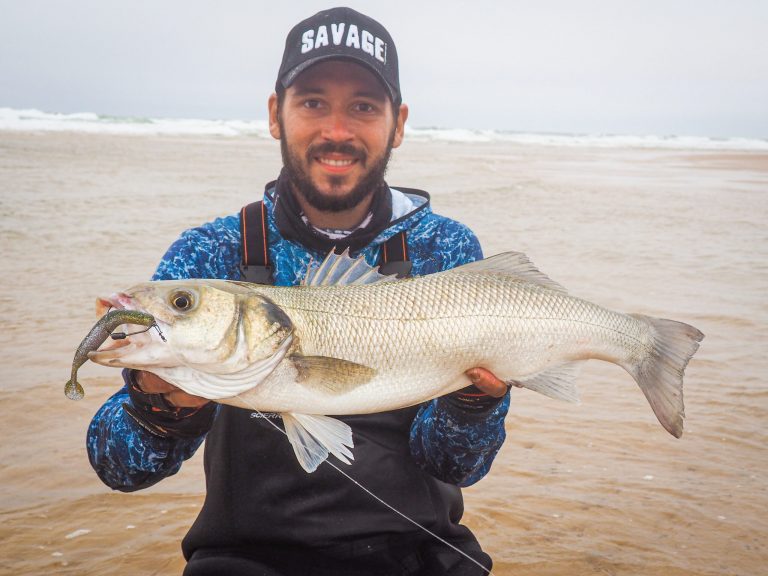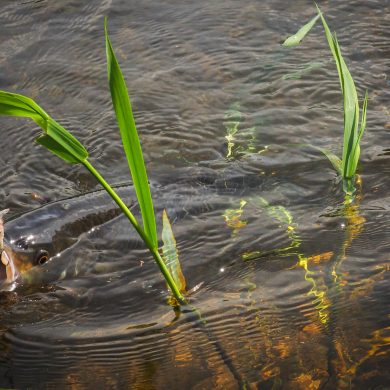Coastal bass fishing
MY APPROACH
We’re getting closer, but high winds and snow storms have put my coastal plans behind a bit. Being sand and chalk in East Anglia, it colours up quickly. A few more weeks of warmth and reasonable conditions, and the bass should turn up. This week I’m going to expand more on my upcoming bass fishing plans. I will cover some of the lures and approaches I use to target bass.
HARD LURES
Hard lures are a popular choice for bass anglers. There are tons to pick from, and collecting them can become an addiction. Some rare patterns can fetch a high price, with anglers seeking out unique designs from the global market. There are many styles to choose from, some which work like sweepers, while others have actions suited to a straight or stop-and-go wind. I prefer long slender profiles that can be wound and jerked, giving a flashy erratic retrieve. One pattern I used a lot last season, when the big sandeel and launce moved in, was the Savage Sandeel Jerk. The big 17.5cm version was my go-to lure. Long and heavy, they have a good casting range. Winding them a few metres, before adding some aggressive jerks, often proved the best retrieve. Bass hit them hard and it’s a pure adrenaline rush. You get that sensation like you’ve hit a wall, before the drag starts peeling off. For most situations hard lures around 14cm and 20g are perfectly suitable for bass. Many feature clever weigh systems to improve casting range. Diving depths between 3ft and 6ft suit most venues. Many topwater lures fall into the hard lure category. I don’t use them often but enjoy pop and walk styles for explosive takes.
METALS
Casting jigs and inline spoons make up a large part of my box. Extreme casting range makes them perfect for covering water. When using these I like to keep mobile. Often walking long sections of barren coastline while casting. Covering ground will often locate a shoal of fish. Most of my metals are 15g – 35g, and up to 14cms in size. Sometimes an active retrieve, working them near the surface, produces fish. Often for me, jigging them back and covering the water column will pick up fish. It pays to experiment with retrieves. Many metals like the Savage Seekers will spin on the drop, and rise in the water column quickly. This makes them perfect for a jigging retrieve over medium depths of water, while being able to fish them right through the shallows. Classics like the Toby spoon are still really productive today, and many people have a few kicking around the lure box.
SOFT PLASTICS
Soft plastics are by far my most effective lure for targeting bass. I like to fish them with an aggressive jigging approach in rough conditions. The Savage Gear Sandeel Kits are a great selection to start with, offering plenty of options. They’ve produced a lot of fish for me. The jig heads have a stinger eye, perfect for attaching an underspin blade. I’ve found the flash makes a difference in choppy, milky conditions. Weedless options may suit some venues better. The Storm 360GTs and Fiiish Black Minnows are perfect options. Weightless and weighted worms are a great choice suited to a variety of venues. Long casting options like the Wave Worms and Gravity Sticks can be fished in many ways. It’s incredible how much action you can get from them. Twitching them back over rock and reef. Working them high as a top water. Sometimes less is more and creeping them back produces exciting takes.
WHAT TO LOOK FOR
The type of kit I use and what I look for when searching for bass. When it comes to rods I look for one that covers all the situations I might face. When confronted by miles of sand, chalk and shingle, carrying multiple outfits isn’t an option. A long rod is perfect for bass fishing and aids casting. I use a 9ft 6inch, 15g-42g casting weight model. This covers me from my lightest to my heaviest lures. With bass often being hard hitters, a rod with a fairly soft tip is favourable. Lots of flex reduces hook pulls, while plenty of power in the lower blank will absorb big runs. The downside to a soft-tipped rod is reduced hook sets on big weedless lures. You often have adjust for a bigger strike or consider faster rods, if that’s your primary style of fishing. When it comes to reels, 3000-4000 sizes offer great line lay and casting ability. Many saltwater options are available, but washed down and maintained properly, even cheaper reels will hold up to the job. Although as I’ve found out in the past, dropping them in salty, sandy, water wrecks them fairly quickly.
Braid between 17 and 20 pounds holds up great to regular abuse. Lighter braids are better for some situations but I find I’m replacing them more often. Matching fluorocarbon makes a great hook length, attached with the FG knot, it will stand up to abuse. I’ve began to favour long fluorocarbon lengths of 12ft or so, due to its brilliant abrasion resistance.
Lastly, location. The Anglian coastline doesn’t have as diverse a habitat range as other coastlines. We have sand, sand and more sand. The occasional bit of shingle and chalk reef exists. Any structure from an artificial reef, pier, groin or estuary mouth can hold fish. Covering ground around these areas is effective. It’s great to travel light and just fish as you go. Flood tides are great for covering freshly submerged structure. It pays to fish all stages of the tide on new spots, feeding habits can vary from location to location.
With restrictions now lifting, I have plans to try something I haven’t done before, which I’m looking forward to covering in next week’s blog.







